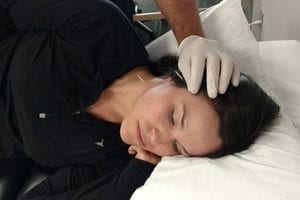Muscle pain affects almost everyone at some point in their lives. This pain can be a nuisance or can be debilitating to the sufferer. This pain can lead to “knots”, or trigger points, in the muscle which may lead to pain or secondary problems. One of the treatments for this type of symptom involves the insertion of thin needles into the trigger point through the skin. This technique is called dry needling and is quickly gaining popularity. One of the common misconceptions is that dry needling is the same as acupuncture. There are some similarities in the two but overall the two procedures are very different.
What is Acupuncture?
Acupuncture has been used for thousands of years, originating in Chinese medicine. Acupuncture achieves pain relief through the release of endorphins. It is said to create a balance in the body’s energy flow or chi achieved by inserting thin filiform needles into specific areas of the body. The location of the needle placement if based on meridian system. Acupuncture is performed by trained and licensed acupuncturists.
What is Dry Needling?
Dry needling is a newer technique that involves reducing or eliminating trigger points by inserting a thin filiform needle into the affected muscle. This will typically cause muscle relaxation, alleviating pain and dysfunction. Dry needling is preformed in a clinical setting by highly trained practitioners.
Dry Needling and Acupuncture are similar in the fact that they use needles that are inserted into the skin in a similar tapping fashion. This is where the similarities end. Dry Needling is based on the modern study of the musculoskeletal and the nervous systems. At Makovicka Physical Therapy, needles specifically for dry needling are used. The needles are inserted directly into the affected muscle with the trigger point. By doing this, the “knot” is released relieving the spasm and pain associated with this area of the body. Side effects from dry needling may vary among individual and are typically mild. The most common complaints are slight muscle soreness and bruising at the insertion site.
Benefits of Dry Needling
Many patients experience a dramatic and often times immediate relief of muscular pain and stiffness. This commonly leads to improved range of motion and muscle performance allowing for participation in a comprehensive exercise program to maximize your recovery. Dry needling has been shown to be beneficial for a wide variety of diagnoses including sports injuries, fibromyalgia, back pain, acute and chronic pain.

